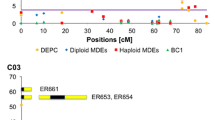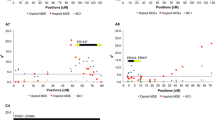Summary
The segregation of 12 heterozygous isozyme markers was analyzed among F2 plants and 51 anther culture (AC)-derived lines obtained from the japonica × indica cross of rice, IRAT 177 × Apura. All the lines except two were homozygous products of recombination of the two parental phenotypes. Doubled haploid (DH) lines derived from plants regenerated from the same callus were identical, confirming previously obtained results in rice. Surprisingly, some lines derived from different calli were also identical, suggesting a phenomenon of early callus fragmentation. All these observations at the isozyme level were confirmed by field evaluation. Deviations of segregations from the expected 1 : 1 ratio were observed at 4 loci among the DH lines. Among these, two were also noted among the F2 plants. The two other distortions, both in favor of the japonica allele, were observed specifically in the AC-derived materials.
Although this concerns a small proportion of the genes under study, it suggests that the embryogenic microsporal population does not represent a random gametic array. On the other hand, evaluation of recombination between isozyme genes located on chromosome 6 appears consistent with F2 data and data previously recorded on the other japonica × indica crosses. The potential use of isozymes in breeding doubled haploids derived from remote crosses in rice is discussed.
Similar content being viewed by others
Abbreviations
- MCPA =:
-
2-methyl-4-chlorophenoxyacetic acid
- IAA =:
-
indolacetic acid
- AC plant or line =:
-
anther culture-derived plant or line
- DH line =:
-
doubled haploid line
References
Bui Dang Ha D. & J. Pernès, 1982. Androgenesis in Pearl Millet; 1. Analysis of plants obtained from microspore culture. Z. Pflanzen physiol. 108: 317–327.
Chen C.M., C.C. Chen & M.H. Lin, 1982. Genetic analysis of anther-derived plants of rice. J. Hered. 73: 49–52.
Chen Y. & L.T. Li, 1978. Investigation and utilization of pollen derived haploid plants in rice and wheat. In: Proc. of the Symp. on Plant Tissue Culture. Science Press, Beijing, China. pp. 199–211.
Chen C.C., W.L. Chiu, L.J. Yu, S.S. Ren, W.J. Wu & M.H. Lin, 1983. Genetic analysis of anther-derived plants of rice; independent assortment of unlinked genes. Can. J. Genet. Cytol. 25: 18–24.
Chu, C.C., 1978. The N6 medium and its application to anther culture of cereal crops. In: Proc. of the Symp. on Plant Tissue Culture. Beijing, China. pp. 43–50.
Corduan G., 1975. Isozyme variation as an indicator for the generative or somatic origin of anther derived plants of Digitalis purpurea L. Z. Pflanzenzucht. 76: 47–55.
Foroughi-Wehr B. & W. Friedt, 1984. Rapid production of recombinant barley yellow mosaic virus resistant Hordeum vulgare lines by anther culture. Theor. Appl. Genet. 67: 377–382.
Glaszmann J.C., 1985. Variabilité enzymatique du riz (Oryza sativa L.); son importance pour la compréhension de la structure écogéographique de l'espèce. IRAT. Paris, Memoires et Travaux de l'IRAT n-9. 126 p.
Glaszmann J.C., 1987. Isozymes and classification of Asian rice varieties. Theor. Appl. Genet. 74: 21–30.
Glaszmann J.C., H. Benoit & M. Arnaud, 1984. Classification des riz cultivés (Oryza sativa L.). Utilisation de la variabilité isoenzymatique. L'Agron. Trop. 39: 51–66.
Guiderdoni E., B. Courtois, R. Dechanet & P. Feldmann, 1986. La production de lignées haploides doublées de riz (Oryza sativa L.) par culture d'anthères in vitro. L'Agron. Trop. 41: 250–257.
Ikehashi M. & H. Araki, 1985. Genetics of F1 sterility in remote crosses of rice. In: Rice Genetics, IRRI, P.O. Box 933, Manila, Philippines. pp. 119–130.
Kao, K.N., L.R. Wetter, J. Dyck, D. Horn, C.M. Ye & B.L. Harvey, 1983. Inheritance of certain genetic traits in pollen plants from F1 hybrid barley. Genet. Soc. Can. Bull. 14.
Kato S., H. Kosaka & S. Hara, 1928. On the affinity of rice varieties as shown by the fertility of rice plants. Centr. Agric. Inst. Kyushu Imp. Univ. 2: 241–276.
Keathley D.E. & R.L. Scholl, 1983. Chromosomal heterogeneity of Arabidopsis thaliana anther callus regenerated shoots and plants. Z. Pflanzenphysiol. 112: 247–255.
Kinoshita, T., 1982. Fundamental problems on haploid breeding by means of anther culture of rice plants. In: Proc. of the 5th Int. Cong. on Plant Tissue Cell Cult. Tokyo, Japan. pp. 567–568.
Matsuo T., 1952. Genecological studies on cultivated rice (in Japanese). Bull. Nat. Inst. Agric. Sci. Jpn. D 3: 1–111.
Morishima H. & J.C. Glaszmann, 1986. Gene symbols for isozymes. Rice Genet. Newsl. 3: 15–17.
Oka H.I., 1958. Intervarietal variation and classification of cultivated rice. Indian J. Genet. Plant Breed. 18: 79–89.
Oka H.I., 1974. Analysis of genes controlling F1 sterility in rice by the use of isogenic lines. Genetics 77: 521–534.
Oono K., 1975. Production of haploid plants of rice (Oryza sativa) by anther culture and their use for breeding. Bull. Nat. Agric. Sci. 26: 139–222.
Orton T.J. & M.A. Browers, 1985. Segregation of genetic markers among plants regenerated from cultured anthers of broccoli. Theor. Apll. Genet. 69: 637–643.
Powell W., E.M. Borrino, M.J. Allison, D.W. Griffiths, M.J.C. Asher & J.M. Dunwell, 1986. Genetical analysis of microspore derived plants of barley (Hordeum vulgare). Theor. Appl. Genet. 72: 619–626.
Ranjhan S., J.C. Glaszmann, D.A. Ramirez & G.S. Khush, 1987. Chromosomal location of four isozyme loci by trisomic analysis in rice (Oryza sativa L.). Theor. Appl. Genet. 75: 541–545.
Second G., 1982. Origin of the genetic diversity of cultivated rice (Oryza spp); study of the polymorphism scored at 40 isozyme loci. Jpn. J. Genet. 57: 25–57.
Second G. & P. Trouslot, 1980. Polymorphisme de 13 zymogrammes observés parmi diverses espèces sauvages et cultivées du genre Oryza. In: Electrophorèse d'enzymes de riz. ORSTOM, Paris. Travaux et documents de l'ORSTOM n-120. 88 p.
Shastry S.V.S., D.R.R. Rao & R.N. Misra, 1960. Pachytene analysis in Oryza; I. Chromosome morphology in Oryza sativa L. Indian J. Genet. Plant Breed. 20: 15–21.
Shen T.T., C.C. Hsueh & C. Liu, 1978. Genetic behavior of pollen plants in paddy rice. (in Chinese). In: Proc. of the Symp. on Ant. Cult. Science Press, Beijing. China. pp. 255–257.
Tanksley S.D. & M. Rick, 1980. Isozyme linkage map in tomato; applications in genetics and breeding. Theor. Appl. Genet. 57: 161–170.
Wenzel G., F. Hoffmann & E. Thomas, 1976. Heterozygous microspore-derived plants in rye. Theor. Appl. Genet. 48: 205–208.
Woo S.C. & H.Y. Su, 1975. Doubled haploid rice from indica and japonica hybrids through anther culture. Bot. Bull. Acad. Sin. 16: 19–24.
Wu K.S., J.C. Glaszmann & G.S. Khush, 1988. Chromosomal location of ten isozyme loci in rice through trisomic analysis. Biochem. Genet. 26: 303–320.
Zamir D., S.D. Tanksley & R.A. Jones, 1981. Genetic analysis of the origin of plants regenerated from anther tissues of Lycopersicon esculentum Min. Plant Sci. Lett. 21: 223–227.
Author information
Authors and Affiliations
Rights and permissions
About this article
Cite this article
Guiderdoni, E., Glaszmann, J.C. & Courtois, B. Segregation of 12 isozyme genes among doubled haploid lines derived from a japonica x indica cross of rice (Oryza sativa L.). Euphytica 42, 45–53 (1989). https://doi.org/10.1007/BF00042614
Received:
Accepted:
Issue Date:
DOI: https://doi.org/10.1007/BF00042614




